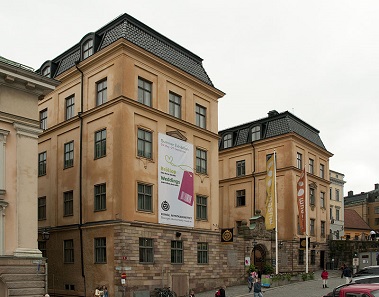by Annika Backe
translated by Christina Schlögl
April 27, 2017 – Every museum curator’s nightmare has come true in Sweden. An stocktaking at the Royal Coin Cabinet in Stockholm has shown that at least 1200 objects have been stolen. And the perpetrator is no stranger. He is a former employee, who is now being put on trial.
The renowned Kungliga Myntkabinettet in Stockholm. Photo: Sören Eriksson / Wikimedia Commons / CC BY-SA 3.0
Since the last audit on occasion of the Coin Cabinet’s move to the old town of Stockholm in 1997, the suspect has stolen an estimated 2.6 million euros (transferred) worth of coins. As chamber prosecutor Jens Nilsson confirmed in front of the Swedish media, the thief was acting alone and has already sold numerous objects.
Prior to this theft, the arrested man had already been convicted of the same offence. He was sentenced to pay 100,000 Swedish crowns (close to 10,400 euros) worth of compensation for stealing stamps from an auction house.
The Coin Cabinet in Stockholm is deeply hurt by this incident. Since 2012, the head of this house, which was founded in the 1570s and houses more than 500,000 objects and the most significant numismatic library in Sweden, has been Eva Ramberg. In a written interview, she has answered the most pressing questions for CoinsWeekly.
CW: Could you give us a brief summary of what has happened?
Eva Ramberg: A comprehensive audit of our collections reveals that over 1,200 objects are missing. It is tragic and the main part of these items are irreplaceable. Part of our shared cultural heritage is gone. The police investigation has been under way since 2013, and since no charges has been brought, some information is confidential.
CW: Can you name some of the objects stolen?
Ramberg: No, not before the charges have been brought.
CW: Will there be an illustrated list of the lost objects that could be forwarded to coin dealers, in order to track down the coins in question?
Ramberg: Maybe later – this is a decision for the investigating police to take.
CW: Is it possible (or has it been done already) to consult with CoinArchives, if the pictures of the stolen material match any of the recently sold material listed there?
Ramberg: This is also a question for the police to answer.
CW: Can you say something on how the theft may have been accomplished technically, and which security measures could have prevented the incident?
Ramberg: I will be able to say more about this when we know more about the charges.
CW: And as a message to other museum colleagues: Do you have some advice as a result of these unfortunate happenings?
Ramberg: Not yet, but I am sure I will have further on in this process.
Although it is now the police and the justice who will have to act, one thing is certain: The Royal Coin Cabinet in Stockholm, which is already officially threatened with closure due to rent increase and whose exhibition capacity is massively impaired by its move to the Swedish History Museum – this Coin Cabinet now has had to bear yet another strike.
If you would like to see the Coin Cabinet at its present location, you should hurry. According to the website of the Coin Cabinet, visiting the exhibition will only be possible until 20 August 2017.
You can find out more about the closing of the Coin Cabinet in this CoinsWeekly article by Harald Nilsson. Another article by Eva Ramberg and Maria Jansén revolves around the Coin Cabinet’s new location as a part of the Swedish History Museum.
Background articles on Swedish coinage can be found in CoinsWeekly here, here and here.
And it was only recently that CoinsWeekly reported on a spectacular theft at the Berlin Coin Cabinet.





